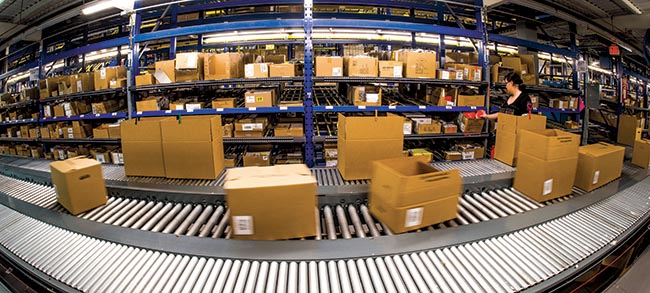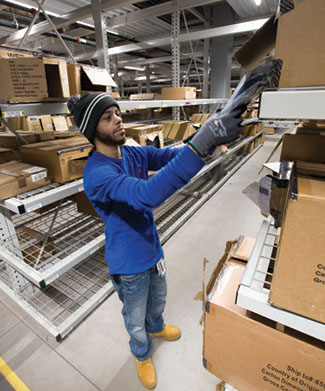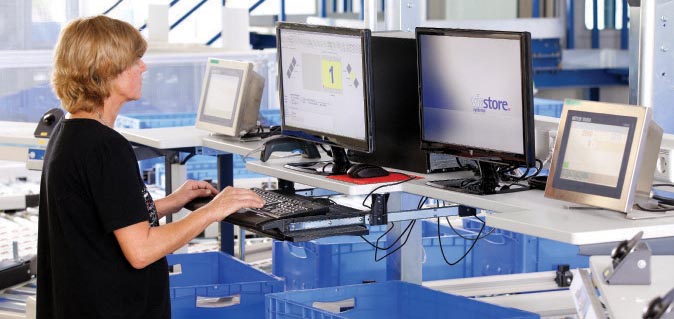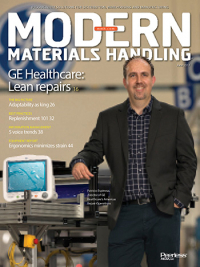Replenishment 101: Tipping the Scales in Favor of Productivity
The tightrope strung between storage and picking is an ever-changing balancing act to optimize labor and throughput.
Welcome to Warehouse Basics, a five-part series in which Modern will unpack the essential elements of functional areas in the warehouse. The first entry in the series was focused on receiving, followed by putaway. We’ll now turn to replenishment before picking and lastly packing/shipping. Informed by industry experts, these articles are intended to capture a snapshot of the current state of materials handling practices.
So far in the Warehouse Basics series we have received goods, staged them for putaway, and directed them to storage to await demand. The replenishment function is now responsible for the movement of product from storage—or, in some operations, directly from receiving—to where it will be picked.
The forward pick area represents pickable SKUs in a smaller footprint than reserve storage so as to facilitate productive picking with minimal travel distance. Forward pick areas might consist of pallet flow rack or pallet floor pick, or just a few cases, or even product that has been decanted to totes kept in an automated storage and retrieval system (AS/RS) for goods-to-person picking.
Replenishment is typically triggered by need in the forward pick line. That trigger, the lower threshold at which a replenishment task is created, is the minimum. The quantity to be moved from storage to a forward pick location should fill that location to its maximum. For example, when a case flow lane holding seven cases has two remaining, a replenishment task will direct five cases to the pick location. Or, when a three-pallet location is down to two, another is requested.
The min/max rules can also be adjusted based on logical replenishable quantities. For example, if there are 15 cases in each pallet of a SKU with daily demand for 10 cases, a replenishment task should be set for no less than 15 cases, or increments thereof.
There is no single min/max rule that covers all SKUs and scenarios. These SKU-specific min/max rules are intended to balance the frequency of replenishment, the efficiency of each replenishment task, and the efficiency of the pick line to optimize productivity and minimize labor.
The rules should take into account:
- The size of the pick face: A pick face that is too small for the demand against it will drive too many replenishments and productivity will suffer. The goal is to have as few replenishments as possible while maintaining the smallest possible pick face.
- How much product is available in inventory: If there is not enough in storage to stay ahead of picking demand, product can be sent directly to the pick area after it is received. To minimize touches, this pick replenishment task might be ordered even before the min is reached. (Not all systems offer this functionality, and instead require product be first placed into storage.)
- The cube velocity of the SKU: Even if they are ordered at the same rate, a box of pens and a 24-pack of toilet paper need forward pick locations appropriate to their dimensions and volume.

When a pick location reaches its minimum, the warehouse management system (WMS) will issue a replenishment task. This might instruct a forklift operator to retrieve and deliver a full pallet, at which point the replenishment task is complete. Other setups have a two-step replenishment process, where for example an order picker retrieves cases of one or more SKUs and presents them to a second replenisher at the pick module. This person might then simply place boxes in the pick location, or perform other value-added tasks to make the product pick-ready, like opening a case or labeling eaches.
Ideally, replenishment does not interfere with picking, such as a pick module where picking occurs on one side and replenishment on the other. In automated storage systems, it’s best to have separate induction and picking areas, because at high volume the system can’t afford to take capacity out of outbound flow. There are some scenarios when a cross-trained picker with free time might perform some replenishment tasks, or vice versa, but generally it is best to keep pickers picking.
Roles and responsibilities
 Slotting, the placement and sizing of forward pick faces, must be balanced with min/max rules to ensure efficient replenishment and picking. If a two-case pick face is tasked with filling orders for 10 cases per day, that one location will require five replenishments per day. If there are 20 cases to a pallet, it makes more sense to make that SKU a pallet pick location, where one replenishment can cover two days of demand.
Slotting, the placement and sizing of forward pick faces, must be balanced with min/max rules to ensure efficient replenishment and picking. If a two-case pick face is tasked with filling orders for 10 cases per day, that one location will require five replenishments per day. If there are 20 cases to a pallet, it makes more sense to make that SKU a pallet pick location, where one replenishment can cover two days of demand.
On the other hand, a series of pick faces each holding two weeks of demand will produce a massive forward pick area that requires lots of wasted travel and will lower picker productivity. The most extreme example of this is a zero-replenishment model where all picking occurs from storage locations. In this case, replenishment labor is zero, but picking labor skyrockets as a picker covers the entire warehouse to assemble an order. Somewhere between the two extremes is the optimal balance of labor cost and productivity.
Of course, the balance never stays balanced, so to speak. E-commerce operations in particular are very sensitive to seasonal volumes. In May, it’s more likely that a cross-trained worker will float from task to task. In November, nobody wants to hire more pickers than needed, since picking tends to be a more articulated skill with more detailed training than putaway and replenishment. Flexibility in staffing is good, but it’s better to plan for the most productive methodology and flex only when needed.
When the replenishment balance is off, two symptoms will emerge. First, the pick face will continually run out of stock, which precludes the system from dropping orders or results in a picker arriving at an empty location. Second, replenishment labor will increase if the min/max is set for only a half-day’s supply. Instead of replenishing 10 times a week, it is better to take action to adjust the rhythm to one or two times a week, on average.
Re-slotting exercises are periodic opportunities to adjust the balance. How periodic these exercises are is a balancing act all its own, determined first by practicality. The limitations or capabilities of software systems will also influence whether reslotting is scheduled annually, quarterly, seasonally or more frequently. Slotting solutions designed for the mass market might also need tweaking to handle something like nested flower pots, for example. If each is 1 cubic foot, two nested pots do not add up to 2 cubic feet.

In the case of seasonality, if a promotion or SKU begins to take off, it’s important to maintain an average of, say, a five-day supply, which could rapidly shift from three cases to five pallets. Historical sales or projections might allow an operation to take a proactive rather than reactive stance to these changes. The better the operation is able to predict future demand, the more surgical it can be with slotting decisions.
Does a given SKU need to be moved to a bigger pick face? An eight-deep case flow will require half the replenishments as the current four-deep. Again, depending on system capabilities or the keen eye of an inventory manager, that transition can be made to happen dynamically. Instead of moving product, simply let the four-deep run to empty while replenishing to the new eight-deep location.
To enable this flexibility, the forward pick area must be designed for additional slots beyond what is needed for active picking. The general goal is 10% to 15% slot availability for each type of slot. This correlates to the rule of thumb that productivity will suffer when a warehouse surpasses 85% capacity.
Some of these lessons can be missed in an environment where so much attention and resources are focused on the picking side of the equation. Detailed analysis of replenishment labor and patterns can produce savings and efficiencies, which will only improve pick productivity. The reason picking gets the focus is that all other steps in the warehouse—from receiving to putaway to value-add to replenishment—are in support of picking and assembling the order.
In the next installment of Warehouse Basics, we’ll delve into the fundamentals of picking. A complex, critical and rapidly evolving process, picking could easily fill an entire issue, but we’ll try to cover as much as possible while dividing the story into less-than and more-than case picking. Stay tuned for that story in the September issue, followed by the final installment of Warehouse Basics, focused on packing and shipping, to appear in the October issue.
This story was created with generous support from Bryan Jensen, who has 34 years of experience in retail and wholesale distribution, transportation and logistics and is a principal with St. Onge Co. in York, Pa. Contact Bryan at [email protected].

Article Topics
Inventory & Picking News & Resources
Siemens, Universal Robots, and Zivid partner to unveil smart robotic picking solution AI-based inventory monitoring solution provider Gather AI raises $17 million NRF 2024 retail sales forecast calls for growth Swisslog gives live demonstration of ItemPiQ latest evolution Cimcorp automates fresh food distribution with flexible storage, order picking solutions ABCO Systems acquires FastFetch The Ultimate Guide to Reducing Warehouse Travel More Inventory & PickingLatest in Materials Handling
Hyster recognizes Dealers of Distinction for 2023 Carolina Handling names Joe Perkins as COO C-suite Interview with Keith Moore, CEO, AutoScheduler.AI: MODEX was a meeting place for innovation Walmart deploying autonomous lift trucks at four of its high-tech DCs Coles shops big for automation Kathleen Phelps to join FORTNA as chief financial officer Coles automates grocery distribution in Australia More Materials HandlingAbout the Author
Subscribe to Materials Handling Magazine

Find out what the world's most innovative companies are doing to improve productivity in their plants and distribution centers.
Start your FREE subscription today.
April 2024 Modern Materials Handling

Latest Resources












